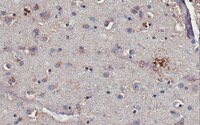MAB5430-C Sigma-AldrichAnti-Tau Antibody, Cleaved (D421), clone Tau-C3, Ascites Free
Anti-Tau Antibody, Cleaved (D421), clone Tau-C3, Ascites Free is an antibody against Tau for use in Immunohistochemistry (Paraffin), Immunofluorescence, Western Blotting, Immunocytochemistry.
More>> Anti-Tau Antibody, Cleaved (D421), clone Tau-C3, Ascites Free is an antibody against Tau for use in Immunohistochemistry (Paraffin), Immunofluorescence, Western Blotting, Immunocytochemistry. Less<<Recommended Products
Overview
| Replacement Information |
|---|
Key Specifications Table
| Species Reactivity | Key Applications | Host | Format | Antibody Type |
|---|---|---|---|---|
| H, M, R | IH(P), IF, WB, ICC | M | Purified | Monoclonal Antibody |
| References |
|---|
| Product Information | |
|---|---|
| Format | Purified |
| Presentation | Purified mouse monoclonal IgG1κ antibody in buffer containing 0.1 M Tris-Glycine (pH 7.4), 150 mM NaCl with 0.05% sodium azide. |
| Quality Level | MQ100 |
| Physicochemical Information |
|---|
| Dimensions |
|---|
| Materials Information |
|---|
| Toxicological Information |
|---|
| Safety Information according to GHS |
|---|
| Safety Information |
|---|
| Storage and Shipping Information | |
|---|---|
| Storage Conditions | Stable for 1 year at 2-8°C from date of receipt. |
| Packaging Information | |
|---|---|
| Material Size | 100 μg |
| Transport Information |
|---|
| Supplemental Information |
|---|
| Specifications |
|---|
| Global Trade Item Number | |
|---|---|
| Catalog Number | GTIN |
| MAB5430-C | 04055977330199 |
Documentation
Anti-Tau Antibody, Cleaved (D421), clone Tau-C3, Ascites Free SDS
| Title |
|---|







